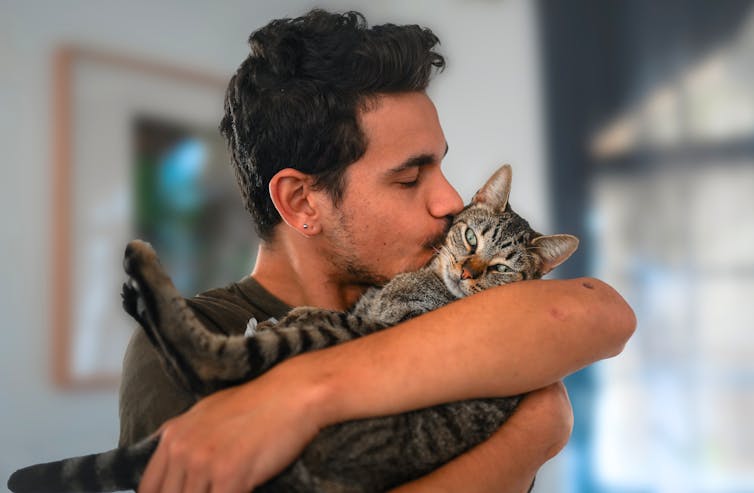Bradley Smith, CQUniversity Australia and Mia Cobb, The University of MelbourneFor many of us, dogs are our best friends. But have you wondered what would happen to your dog if we suddenly disappeared? Can domestic dogs make do without people?
At least 80% of the world’s one billion or so dogs actually live independent, free-ranging lives – and they offer some clues. Who would our dogs be if we weren’t around to influence and care for them?
What are dogs?
Dogs hold the title of the most successful domesticated species on Earth. For millennia they have evolved under our watchful eye. More recently, selective breeding has led to people-driven diversity, resulting in unique breeds ranging from the towering Great Dane to the tiny Chihuahua.
Humanity’s quest for the perfect canine companion has resulted in more than 400 modern dog breeds with unique blends of physical and behavioural traits. Initially, dogs were bred primarily for functional roles that benefited us, such as herding, hunting and guarding. This practice only emerged prominently over the past 200 years.
Some experts suggest companionship is just another type of work humans selected dogs for, while placing a greater emphasis on looks. Breeders play a crucial role in this, making deliberate choices about which traits are desirable, thereby influencing the future direction...
If humans disappeared, what would happen to our dogs?
Read More........ Categories: Animal,Australia,Dog,Matter-Of-Fact,University
What is a sonar pulse and how can it injure humans under water?

Christine Erbe, Curtin UniversityOver the weekend, the Australian government revealed that last Tuesday its navy divers had sustained “minor injuries”, likely due to sonar pulses from a Chinese navy vessel.
The divers had been clearing fishing nets from the propellers of HMAS Toowoomba while in international waters off the coast of Japan. According to a statement from deputy prime minister Richard Marles, despite HMAS Toowoomba communicating with internationally recognised signals, the Chinese vessel approached the Australian ship and turned on its sonar, forcing the Australian divers to exit the water.
The incident prompted a response from the Australian government, who labelled the incident “unsafe and unprofessional”. But what exactly is a sonar pulse, and what kinds of injuries can sonar cause to divers?
What is sonar?
Light doesn’t travel well under water – even in clear waters, you can see perhaps some tens of metres. Sound, however, travels very well and far under water. This is because water is much denser than air, and so can respond faster and better to acoustic pressure waves – sound waves.
Because of these properties, ships use sonar to navigate through the ocean and to “see” under water. The word “sonar” stands for sound navigation and ranging.
Sonar equipment sends out short acoustic (sound) pulses or pings,...
Fieldwork can be challenging for female scientists. Here are 5 ways to make it better

Sarah Hamylton, University of Wollongong; Ana Vila Concejo, University of Sydney; Hannah Power, University of Newcastle, and Shari L Gallop, University of WaikatoWomen coastal scientists face multiple barriers to getting into the field for research. These include negative perceptions of their physical capabilities, not being included in trips, caring responsibilities at home and a lack of field facilities for women. Even if women clear these barriers, the experience can be challenging.
This is a problem because fieldwork is crucial for gathering data, inspiring emerging scientists, developing skills, expanding networks and participating in collaborative research.
Our recent study revisited an international survey of 314 coastal scientists that revealed broad perceptions and experiences of gender inequality in coastal sciences. We offer five ways to improve the fieldwork experience for women.
Our collective experience of more than 70 years as active coastal scientists suggests women face ongoing problems when they go to the field. Against a global backdrop of the #MeToo movement, the Picture a Scientist documentary and media coverage about incidents of sexual harassment in the field, conversations between fieldworkers and research managers about behaviour and policy change are needed.
Our research: what we did and what we...
Is it okay to kiss your pet? The risk of animal-borne diseases is small, but real

Shutterstock Sarah McLean, Swinburne University of Technology and Enzo Palombo, Swinburne University of Technology Our relationship with pets has changed drastically in recent decades. Pet ownership is at an all-time high, with a recent survey finding 69% of Australian households have at least one pet. We spend an estimated A$33 billion every year on caring for our fur babies. While owning a pet is linked to numerous mental and physical health benefits, our pets can also harbour infectious diseases that can sometimes be passed on to us. For most people, the risk is low. But some, such as pregnant people and those with weakened immune systems, are at greater risk of getting sick from animals. So, it’s important to know the risks and take necessary precautions to prevent infections. What diseases can pets carry? Infectious diseases that move from animals to humans are called zoonotic diseases or zoonoses. More than 70 pathogens of companion animals are known to be transmissible to people. Sometimes, a pet that has a zoonotic pathogen may look sick. But often there may be no visible symptoms, making it easier for you to catch it, because you don’t suspect your pet of harbouring germs. Zoonoses can be transmitted directly from pets to humans, such as through contact with saliva, bodily fluids and faeces, or indirectly, such as...
Why Should You Breastfeed Your Baby?

(Photo courtesy of Flushing Hospital Medical Center)Flushing Hospital Medical Center’s New Beginnings unit provides the women and their families with the ultimate birthing experience. Each month, we cover a new topic exploring an important aspect of health and well-being for expectant mothers. This month, we’ll cover the health benefits of exclusive breastfeeding for both mothers and their babies. According to the American Academy of Pediatrics, exclusive breastfeeding involves only feeding breast milk to your baby and no other foods or liquids. It is the best source of nutrition for your infant’s first six months of life. Some of the benefits to babies and mothers include: Providing all necessary nutrients for the baby’s healthy physical development, including vitamin D, iron, and zincPreventing infections and serious health conditions, both during infancy and later in lifeReducing a mother’s risk of conditions such as cancer, type 2 diabetes, and high blood pressureBreastfeeding may become less frequent as your baby starts eating solid foods around six to 12 months of age. For guidance on how you should breastfeed your baby, talk to a lactation consultant or your baby’s doctor or nurse.Flushing Hospital’s New Beginnings unit offers spacious, modern delivery suites and advanced postpartum care, providing you with a safe...
Subscribe to:
Posts (Atom)
